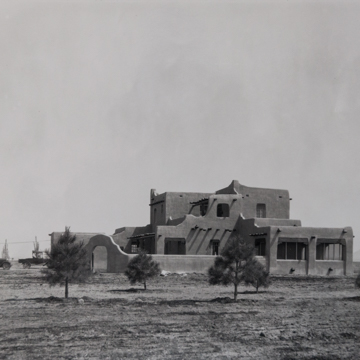You are here
President’s House
Miles Brittelle, who proved himself adept at multiple revival idioms over the course of a long career, produced a charming application of the Spanish-Pueblo style with his design of the President’s House in 1929.
Where T. Charles Gaastra had struggled two years earlier to fit pre-modern models to the realities of a modern gymnasium, Brittelle fluently adapted the imagery of native Pueblos and Spanish Colonial houses to what, in effect, was a conventional upper-middle class house placed on a university campus. Helped by the residential program and scale, Brittelle designed the house as a compact pueblo composed of a stepped and terraced group of buttressed building masses. He gave the brick structure the appearance of adobe by using metal lath to shape brown stucco into the softly rounded profiles and sculptural forms of a traditional earthen construction. Wooden vigas and posts, along with projecting viga ends, complete the effect.
Built at the start of the Great Depression in 1930, the President’s House has been repeatedly remodeled and expanded in answer to the needs of successive presidents, including the addition of a sunroom by John Gaw Meem in 1954–1955. Its original character, however, has survived unchanged.
References
Bunting, Bainbridge. John Gaw Meem: Southwestern Architect. Albuquerque: University of New Mexico, 1983.
Hooker, Van Dorn. Only in New Mexico: An Architectural History of the University of New Mexico. Albuquerque: University of New Mexico, 2000.
University of New Mexico. Department of Facility Planning Records. Center for Southwest Research, University Libraries, University of New Mexico.
University of New Mexico. Department of Facility Planning Drawings. Center for Southwest Research, University Libraries, University of New Mexico.
Writing Credits
If SAH Archipedia has been useful to you, please consider supporting it.
SAH Archipedia tells the story of the United States through its buildings, landscapes, and cities. This freely available resource empowers the public with authoritative knowledge that deepens their understanding and appreciation of the built environment. But the Society of Architectural Historians, which created SAH Archipedia with University of Virginia Press, needs your support to maintain the high-caliber research, writing, photography, cartography, editing, design, and programming that make SAH Archipedia a trusted online resource available to all who value the history of place, heritage tourism, and learning.














